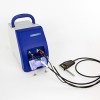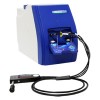
Nanotech
Raman and Nanotechnology
The characterization of carbon nanotubes and graphene can be rapidly done using Raman spectroscopy, which has the ability to distinguish between the various structures of the single-walled nanotubes. The number of layers in a nanomaterial can also be determined by the use of Raman spectroscopy, as can the order of the materials. Analysis of nanomaterials for purity and quality can also be achieved by Raman spectroscopy. Raman spectroscopy one of the techniques for the characterization of graphene-related materials included in the international standard ASTM E3220, Standard Guide for the Characterization of Graphene Flakes, and one the measurement techniques recommended for graphene and graphene-type materials included in ISO/TR 19733.

Products
High throughput, Highly Sensitive, High Resolution Raman System
Highly Sensitive, High Resolution Fiber Optic Raman System
Request a Quote or Information
Application Notes
Read the full application note
Read the full application note
View the Flyer
Read the full article
Read the full article


